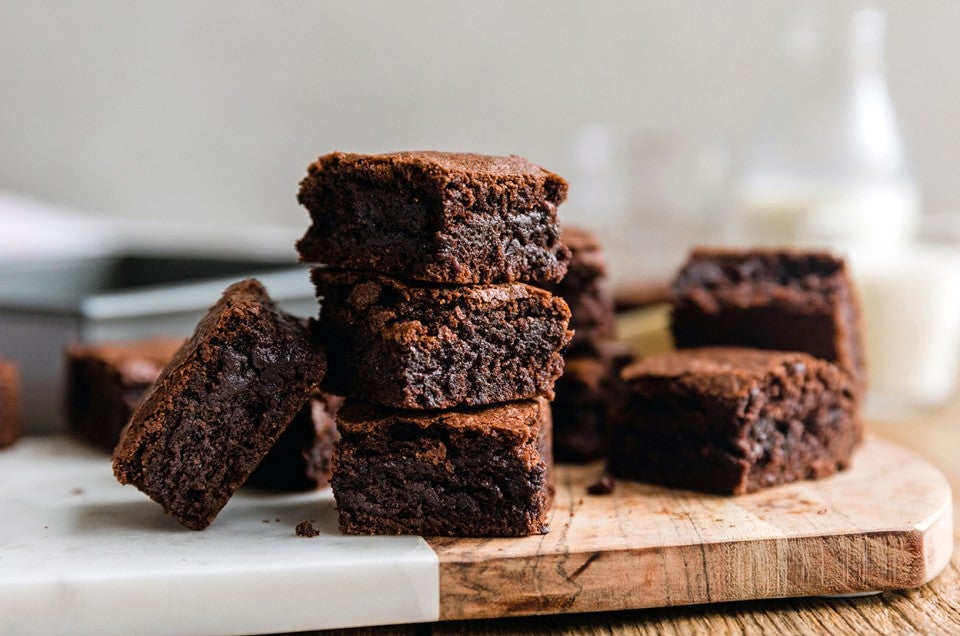4 baked goods that are even better with gluten-free flour
For fudgy brownies and delicate cakes, swap in Measure for Measure.


Gluten-free baked goods are typically defined by what they lack (ahem, you know, gluten.) But we don’t spend enough time talking about what they gain when that gluten is removed — things like a more tender crumb or fudgier texture or crispier edges.
For some baked goods, forgoing the gluten can lead to better results. Think about how gluten itself functions in baking: In our previous post, A beginner’s guide to gluten, we discussed how some baked goods, most notably bread, require a lot of gluten development to achieve a chewy or airy texture. Other baked goods, meanwhile, are best when there’s as little gluten development as possible because they benefit from a tender, rather than chewy, texture. In these baked goods, such as cake or pancakes, bakers handle the batter delicately to minimize gluten development. But there’s another way to stop that gluten network from forming: Ditch the gluten entirely.
The easiest way to do so is to swap in Gluten-Free Measure for Measure Flour for the all-purpose flour called for in a non-yeasted recipe. No other changes needed! And when you make this swap, these four baked goods turn out even better.
Cake is the poster child for when to avoid too much gluten development in a baked good. And for good reason: No one wants a slice of cake that's tough, dense, and gummy from overmixing. So it’s natural that a gluten-free version of a classic butter cake made with Measure for Measure would result in a delightfully soft texture. And indeed, Golden Vanilla Cake made gluten-free yields a cake with a fine grain and even crumb. It’s almost satiny and oh-so-delicate.
It's not just the lack of gluten that achieves this, either. “The higher starch content of gluten-free flours helps contribute to a more moist and tender crumb,” explains Amanda Schlarbaum, a member of our Baker’s Hotline. “It’s the same reason we add starch to cake mixes and cake flour — the starch helps hold the moisture in, resulting in a moist cake.”
The original version of these brownies, made with all-purpose flour, is plenty fudgy. But if you crave a dense, gooey brownie, you can take it up an extra notch by making this recipe gluten-free.
“Our Measure for Measure flour is truly the Avengers of gluten-free ingredients, and brownies are a perfect example of how they all pull their weight in the blend,” says Tess Murphy, another Baker’s Hotline member. “The blended rice and sorghum flours bring in mild grain flavor and body. The tapioca flour adds a nice chewiness, and potato flour locks in moisture.” And lest these ultra-moist brownies turn out too dense, “The xanthan gum works to bind these ingredients to allow them to trap gas bubbles while baking, so the brownies don’t turn out entirely like fudge.”
One of the best ways to start the day is with a steaming, golden waffle, crunchy on the outside and pillowy on the inside. Making Classic Buttermilk Waffles with Measure for Measure accentuates that textural contrast — the waffle’s exterior is almost lacy, with a thin crispiness that yields to a fluffy interior.
According to Tess, the tapioca and potato starch molecules in Measure for Measure absorb moisture when they’re mixed with liquids in a batter. “When direct heat and oil are applied, such as a waffle iron or a greased griddle, the starches swell and push the water back out,” she says. “They cook and harden like this, forming a microscopic brittle structure that feels like a nice crisp crunch when we bite into it.” (She also points out that this is the reason many chefs prefer to use cornstarch over wheat flour when deep frying.)
When a group of King Arthur employee-owners recently tried out our new line of pancake mixes, many of us were surprised to find that we liked the gluten-free pancakes best of all, thanks to their tender texture and light interior. (It’s not just us: One customer shared that her non-gluten-free husband “says it's better than any regular pancake mix that he’s had.”)
Going gluten-free has benefits for all pancakes, not just mixes — Simply Perfect Pancakes prepared with Measure for Measure instead of all-purpose flour are soft and delicate. Similar to waffles, the gluten-free starches crisp nicely from the high heat of the griddle, creating a golden brown exterior ready to soak up maple syrup. Meanwhile, the lack of gluten prevents the batter from getting overworked and the resulting pancakes from turning out rubbery.
Baker's tip: Simply Perfect Pancakes call for either sugar or malted milk powder as an ingredient; if you're baking completely gluten-free, choose the sugar, as malted milk powder is not a gluten-free ingredient.
Remember, it’s important that you choose the right gluten-free flour when baking. If you’re looking to turn a recipe gluten-free by replacing the wheat flour, use Gluten-Free Measure for Measure Flour — it’s specifically designed to replace all-purpose flour in non-yeasted recipes without any changes.
Gluten-Free All-Purpose Flour, meanwhile, is meant for recipes that specifically call for gluten-free flour and xanthan gum (or a similar ingredient); this particular flour cannot be swapped into non-gluten-free recipes.
Ready to start baking? Try one of the recipes in our Gluten-Free Cakes collection and see the difference gluten-free flour can make in your baking.
Cover photo by Shilpa Iyer.